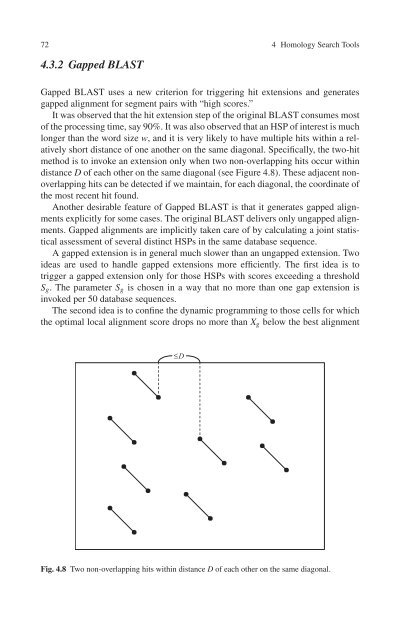You also want an ePaper? Increase the reach of your titles
YUMPU automatically turns print PDFs into web optimized ePapers that Google loves.
72 4 Homology Search Tools<br />
4.3.2 Gapped BLAST<br />
Gapped BLAST uses a new criterion for triggering hit extensions and generates<br />
gapped alignment for segment pairs with “high scores.”<br />
It was observed that the hit extension step of the original BLAST consumes most<br />
of the processing time, say 90%. It was also observed that an HSP of interest is much<br />
longer than the word size w, and it is very likely to have multiple hits within a relatively<br />
short distance of one another on the same diagonal. Specifically, the two-hit<br />
method is to invoke an extension only when two non-overlapping hits occur within<br />
distance D of each other on the same diagonal (see Figure 4.8). These adjacent nonoverlapping<br />
hits can be detected if we maintain, for each diagonal, the coordinate of<br />
the most recent hit found.<br />
Another desirable feature of Gapped BLAST is that it generates gapped alignments<br />
explicitly for some cases. The original BLAST delivers only ungapped alignments.<br />
Gapped alignments are implicitly taken care of by calculating a joint statistical<br />
assessment of several distinct HSPs in the same database sequence.<br />
A gapped extension is in general much slower than an ungapped extension. Two<br />
ideas are used to handle gapped extensions more efficiently. The first idea is to<br />
trigger a gapped extension only for those HSPs with scores exceeding a threshold<br />
S g . The parameter S g is chosen in a way that no more than one gap extension is<br />
invoked per 50 database sequences.<br />
The second idea is to confine the dynamic programming to those cells for which<br />
the optimal local alignment score drops no more than X g below the best alignment<br />
≤D<br />
Fig. 4.8 Two non-overlapping hits within distance D of each other on the same diagonal.

















